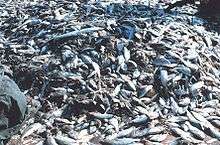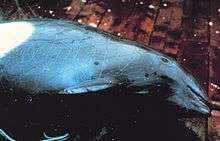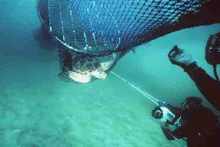Bycatch

Bycatch, in the fishing industry, is a fish or other marine species that is caught unintentionally while catching certain target species and target sizes of fish, crabs etc. Bycatch is either of a different species, the wrong sex, or is undersized or juvenile individuals of the target species. The term "bycatch" is also sometimes used for untargeted catch in other forms of animal harvesting or collecting.
In 1997, the Organisation for Economic Co-operation and Development (OECD) defined bycatch as "total fishing mortality, excluding that accounted directly by the retained catch of target species".[1] Bycatch contributes to fishery decline and is a mechanism of overfishing for unintentional catch.[2]
The fisherman bycatch issue originated due to the “mortality of dolphins in tuna nets in the 1960s” [3]
There are at least four different ways the word "bycatch" is used in fisheries:[4]
- Catch which is retained and sold but which is not the target species for the fishery
- Species/sizes/sexes of fish which fishermen discard[5]
- Non-target fish, whether retained and sold or discarded[6]
- Unwanted invertebrate species, such as echinoderms and non-commercial crustaceans, and various vulnerable species groups, including seabirds, sea turtles, marine mammals and elasmobranchs (sharks and their relatives).
Examples
Recreational fishing
Given the popularity of recreational fishing throughout the world, a small local study in the US in 2013 suggested that discards may be an important unmonitored source of fish mortality.[7]
Shrimp trawling

The highest rates of incidental catch of non-target species are associated with tropical shrimp trawling. In 1997, the Food and Agriculture Organization of the United Nations (FAO) documented the estimated bycatch and discard levels from shrimp fisheries around the world. They found discard rates (bycatch to catch ratios) as high as 20:1 with a world average of 5.7:1.[8]
Shrimp trawl fisheries catch 2% of the world total catch of all fish by weight, but produce more than one-third of the world total bycatch. American shrimp trawlers produce bycatch ratios between 3:1 (3 bycatch:1 shrimp) and 15:1(15 bycatch:1 shrimp).[9]
Trawl nets in general, and shrimp trawls in particular, have been identified as sources of mortality for cetacean and finfish species.[10] When bycatch is discarded (returned to the sea), it is often dead or dying.[11]
Tropical shrimp trawlers often make trips of several months without coming to port. A typical haul may last 4 hours after which the net is pulled in. Just before it is pulled on board the net is washed by zigzagging at full speed. The contents are then dumped on deck and are sorted. An average of 5.7:1 means that for every kilogram of shrimp there are 5.7 kg of bycatch. In tropical inshore waters the bycatch usually consists of small fish. The shrimps are frozen and stored on-board; the bycatch is discarded.[12]
Recent sampling in the South Atlantic rock shrimp fishery found 166 species of finfish, 37 crustacean species, and 29 other species of invertebrate among the bycatch in the trawls.[10] Another sampling of the same fishery over a two-year period found that rock shrimp amounted to only 10% of total catch weight. Iridescent swimming crab, dusky flounder, inshore lizardfish, spot, brown shrimp, longspine swimming crabs, and other bycatch made up the rest.[10]
Despite the use of bycatch reduction devices, the shrimp fishery in the Gulf of Mexico removes about 25–45 million red snapper annually as bycatch, nearly one half the amount taken in directed recreational and commercial snapper fisheries.[13][14]
Cetacean

Cetaceans, such as dolphins, porpoises, and whales, can be seriously affected by entanglement in fishing nets and lines, or direct capture by hooks or in trawl nets. Cetacean bycatch is increasing in intensity and frequency.[15] In some fisheries, cetaceans are captured as bycatch but then retained because of their value as food or bait.[16] In this fashion, cetaceans can become a target of fisheries.

One example of bycatch is dolphins caught in tuna nets. As dolphins are mammals and do not have gills they may drown while stuck in nets underwater. This bycatch issue has been one of the reasons of the growing ecolabelling industry, where fish producers mark their packagings with disclaimers such as "dolphin friendly" to reassure buyers. However, "dolphin friendly" does not mean that dolphins were not killed in the production of a particular tin of tuna, but that the fleet which caught the tuna did not specifically target a feeding pod of dolphins, but relied on other methods to spot tuna schools.
Albatross

Of the 21 albatross species recognised by IUCN on their Red List, 19 are threatened, and the other two are near threatened.[17] Two species are considered critically endangered: the Amsterdam albatross and the Chatham albatross. One of the main threats is commercial long-line fishing,[18] because the albatrosses and other seabirds which readily feed on offal are attracted to the set bait, become hooked on the lines and drown. An estimated 100,000 albatross per year are killed in this fashion. Unregulated pirate fisheries exacerbate the problem.
Sea turtles
Sea turtles, already critically endangered, have been killed in large numbers in shrimp trawl nets. Estimates indicate that thousands of Kemp's ridley, loggerhead, green and leatherback sea turtles are caught in shrimp trawl fisheries in the Gulf of Mexico and the US Atlantic annually[19] The speed and length of the trawl method is significant because, “for a tow duration of less than 10 minutes, the mortality rate for sea turtles is less than one percent, whereas for tows greater than sixty minutes the mortality rate rapidly increases to fifty to one hundred percent”[20]
Sea turtles can sometimes escape from the trawls. In the Gulf of Mexico, the Kemp’s ridley turtles recorded most interactions, followed in order by loggerhead, green, and leatherback sea turtles. In the US Atlantic, the interactions were greatest for loggerheads, followed in order by Kemp’s ridley, leatherback, and green sea turtles.[19]
Mitigation
Concern about bycatch has led fishermen and scientists to seek ways of reducing unwanted catch.[21] There are two main approaches.
One approach is to ban fishing in areas where bycatch is unacceptably high. Such area closures can be permanent, seasonal, or for a specific period when a bycatch problem is registered. Temporary area closures are common in some bottom-trawl fisheries where undersized fish or non-target species are caught unpredictably. In some cases fishermen are required to relocate when a bycatch problem occurs.
The other approach is alternative fishing gear. A technically simple solution is to use nets with a larger mesh size, allowing smaller species and smaller individuals to escape. However, this usually requires replacing the existing gear. In other cases, it is possible to modify gear. The "Bycatch Reduction Device" (BRD) and the Nordmore grate are net modifications that help fish escape from shrimp nets.
BRDs allow many commercial finfish species to escape. The US government has approved BRDs that reduce finfish bycatch by 30%. Spanish mackerel and weakfish bycatch in the South Atlantic was reduced by 40%.[10] However, recent surveys suggest BRDs may be less effective than previously thought.[13] A rock shrimp fishery off Florida found the devices did not exclude 166 species of fish, 37 crustacean species, and 29 species of other invertebrates.[10]
In 1978, the National Marine Fisheries Service (NMFS) started to develop turtle excluder devices (TEDs). A TED uses a grid which deflects turtles and other big animals, so they exit from the trawl net through an opening above the grid. US shrimp trawlers and foreign fleets which market shrimp in the US are required to use TEDs. Not all nations enforce the use of TEDs.
For the most part, when they are used, TEDs have been successful reducing sea turtle bycatch.[10][22][23] However, they are not completely effective, and some turtles are still captured.[10][19] NMFS certifies TED designs if they are 97% effective. In heavily trawled areas, the same sea turtle may pass repeatedly through TEDs.[19] Recent studies indicate recapture rates of twenty percent or more, but it is not clear how many turtles survive the escape process.[19]
The size selectivity of trawl nets is controlled by the size of the net openings, especially in the "cod end". The larger the openings, the more easily small fish can escape. The development and testing of modifications to fishing gear to improve selectivity and decrease impact is called "conservation engineering."

Longline fishing is controversial in some areas because of by-catch. Mitigation methods have been successfully implemented in some fisheries. These include:
- weights to sink the lines quickly
- streamer lines to scare birds away from baited hooks while deploying the lines
- setting lines only at night with minimal ship lighting (to avoid attracting birds)
- limiting fishing seasons to the southern winter (when most seabirds are not feeding young)
- not discharging offal while setting lines.
However, gear modifications do not eliminate by-catch of many species. In March 2006, the Hawaiʻi longline swordfish fishing season was closed due to excessive loggerhead sea turtle by-catch after being open only a few months, despite using modified circle hooks.
One solution that Norway came up with to reduce bycatch is to, “adopt a ‘no discards’ policy”. This means that the fishermen must keep everything they catch. This policy has helped to, “encourage [bycatch] research”, which, in turn has helped “encourage behavioral changes in fishers” and “reduce the waste of life” as well.[24]
Alternative to release
Some fisheries retain bycatch, rather than throwing the fish back into the ocean. Sometimes bycatch are sorted and sold as food,[25] especially in Asia, Africa and Latin America where cost of labour is cheaper. Bycatch can also be sold in frozen bags as "assorted seafood" or "seafood medley" at cheaper prices. Bycatch can be converted into fish hydrolysate (ground up fish carcasses) for use as a soil amendment in organic agriculture or it can be used as an ingredient in fish meal. In Southeast Asia bycatch is sometimes used as a raw material for fish sauce production. Bycatch is also commonly de-boned, de-shelled, ground and blended into fish paste or moulded into fish cakes (surimi) and sold either fresh (for domestic use) or frozen (for export). This is commonly the case in Asia or by Asian fisheries. Sometimes bycatch are sold to fish farms to feed farmed fish, especially in Asia.
If bycatch is quickly released, predators and scavengers may consume it.
Non-fisheries bycatch
The term "bycatch" is used also in contexts other than fisheries. Examples are insect collecting with pitfall traps or flight interception traps for either financial, controlling or scientific purposes (where the bycatch may either be small vertebrates[26] or untargeted insects) and control of introduced vertebrates which have become pest species like the muskrat in Europe (where the bycatch in traps may be e.g. European mink[27] or waterfowl).
See also
References
- ↑ OECD (1997) Towards sustainable fisheries: economic aspects of the management of living marine resources. OECD Paris.
- ↑ C. Michael Hogan. 2010. Overfishing. Encyclopedia of Earth. National Council for Science and the Environment. eds. Sidney Draggan and C. Cleveland. Washington DC.
- ↑ Hall, M. A., Alverson, D. L., & Metuzals, K. I. (2000). By-catch: problems and solutions. Marine Pollution Bulletin, 41(1), 210.
- ↑ Alverson D L, Freeberg M K, Murawski S A and Pope J G (1994). A global assessment of fisheries bycatch and discards. Rome: FAO.
- ↑ A definition used particularly in the Northeast and Western Pacific and in American legislation
- ↑ Hall, M A (1996). "On bycatches". Reviews in Fish Biology and Fisheries. 6 (3): 319–352. doi:10.1007/BF00122585.
- ↑ McCallum ML, Worley GM, Safi B, Dickens K, Jones J et al (2013) By-catch in a recreational fishery: an unmonitored source of mortality. PeerJ Preprints 1:e120v1
- ↑ Clucas, Ivor (1997). Discards and bycatch in shrimp trawl fisheries. FAO Fisheries Circular.
- ↑ Hall, M; Alverson, DL; Metuzals, KI (2000). "By-catch: problems and solutions". Marine Pollution Bulletin. 41 (1–6): 204–219. doi:10.1016/S0025-326X(00)00111-9.
- 1 2 3 4 5 6 7 SAFMC (2004)
- ↑ Morgan, LE; Chuenpagdee, R (2003). Shifting Gears. Addressing the Collateral Impacts of Fishing Methods in U.S. Waters.
- ↑ Clucas, I.; Teutscher, F., eds. (1999). FAO/DFID Expert Consultation on Bycatch Utilization in Tropical Fisheries. Beijing (China), 21–28 Sep 1998. University of Greenwich, NRI. p. 333. ISBN 0-85954-504-0.
- 1 2 Gulf of Mexico Fishery Management Council (GMFMC) (2006) Scoping Document for Amendment 15 to the Shrimp FMP
- ↑ Gulf of Mexico Red Snapper: Assessment Summary Report (PDF). Southeast Data, Assessment, and Review (SEDAR) Stock Assessment Report of SEDAR. 2005.
- ↑ Demaster, DJ; Fowler, CW; Perry, SL; Richlen, ME (2001). "Predation and competition: the impact of fisheries on marine mammal populations over the next one hundred years". Journal of Mammalogy. 82 (3): 641–651. doi:10.1644/1545-1542(2001)082<0641:PACTIO>2.0.CO;2.
- ↑ Read, AJ, Drinker, P, and S Northridge (2006). "Bycatch of marine mammals in the U.S. and global fisheries". Conservation Biology. 20 (1): 163–169. doi:10.1111/j.1523-1739.2006.00338.x. PMID 16909669.
- ↑ IUCN, 2004. Red List: Albatross Species Archived April 27, 2006, at the Wayback Machine.. Retrieved July 27, 2007.
- ↑ Brothers NP (1991). "Albatross mortality and associated bait loss in the Japanese longline fishery in the southern ocean". Biological Conservation. 55 (3): 255–268. doi:10.1016/0006-3207(91)90031-4.
- 1 2 3 4 5 Epperly, S; Avens, L; Garrison, L; Henwood, T; Hoggard, W; Mitchell, J; Nance, J; Poffenberger, J; Sasso, C; Scott-Denton, E and; Young, C (2002). "Analysis of Sea Turtle Bycatch in the Commercial Shrimp Fisheries of Southeast US Waters and the Gulf of Mexico" (PDF). NOAA Technical Memorandum NMFS-SEFSC-490. Retrieved December 2009. Check date values in:
|access-date=(help) - ↑ Nada, M., & Casale P. (2011). Sea turtle bycatch and consumption in Egypt threatens Mediterranean turtle populations. Fauna & Flora International, Oryx, 45(1), 148. doi : 10.1017/S0030605310001286
- ↑ Campaign for Eco-Safe Tuna Retrieved 2.21.2012
- ↑ "Final Amendment Number 13 to the Fishery Management Plan for the Shrimp Fishery of the Gulf of Mexico" (PDF). US Waters with Environmental Assessment Regulatory Impact Review, and Regulatory Flexibility Act Analysis. 2005.
- ↑ Crowder, 2001
- ↑ Hall, M. A., Alverson, D. L., & Metuzals, K. I. (2000). By-catch: problems and solutions. Marine Pollution Bulletin, 41(1), 207.
- ↑ Engelhardt, Elizabeth, "An Oyster by Any Other Name", Southern Spaces, 18 April 2011
- ↑ "Bycatch, ethics and pitfall traps". Journal of Insect Conservation. 3 (1): 1–3. 1999. doi:10.1023/A:1017191920328.
- ↑ Kranz A, Polednik L and Gotea V (2001) Conservation of the European Mink (Mustella lutreila) in the Danube Delta Background information and project plan. Scientific Annals of the Danube Delta Institute for Research and Development, Tulcea, 2000–2001.
Further reading
- FAO (2009) Technical Guidelines for Responsible Fisheries, Number 1: Fishing operations, supplement 2 Best practices to reduce incidental catch of seabirds in capture fisheries Rome. ISBN 978-92-5-106423-8.
- FAO (1997) A STUDY OF THE OPTIONS FOR UTILIZATION OF BYCATCH AND DISCARDS FROM MARINE CAPTURE FISHERIES
- Karp WA, Desfosse LL and Brooke SG (2011) U.S. National Bycatch Report National Marine Fisheries Service, NOAA Technical Memo NMFS-F/SPO-117E.
- SAFMC (1998) Final Habitat Plan for the South Atlantic Region Essential Fish Habitat Requirements for Fishery. Management Plans of the South Atlantic Fishery Management Council. The Shrimp Fishery Management Plan (FMP), the Red Drum FMP, the Snapper Grouper FMP, the Coastal Migratory Pelagics FMP, the Golden Crab FMP, the Spiny Lobster FMP, the Coral, Coral Reefs, and Live/Hard Bottom Habitat FMP, the Sargassum Habitat FMP, and the Calico Scallop FMP.
- U.S. Shrimp (South Atlantic and Gulf of Mexico) – Blue Ocean Institute. Retrieved 22 March 2008.
External links
- Mitigating Adverse Ecological impacts of open oceanfisheries – European project MADE (film 28 min)
- WWF Smart Fishing Global Initiative
- Bycatch – Smithsonian Ocean Portal
- Bycatch Mitigation Information System – references, descriptions, regulations, links
- Lenfest Ocean Program publication on regional governance of bycatch in tuna fisheries
- Project GLOBAL: Global Bycatch Assessment of Long-Lived Species project
- Oceana facts about bycatch/dirty fishing
- FAO document on bycatch and discard
- Greenpeace facts about bycatch
- Alaska Marine Conservation Council
- Johnson, Douglas H; Shaffer, Terry L and Gould, Patrick J (1990)Incidental Catch of Marine Birds in the North Pacific High Seas Driftnet Fisheries U.S. Geological Survey.
- Valdemarsen, John W Incidental catch of seabirds in longline fisheries UN Atlas of the Oceans: Fishery Technology Service.




